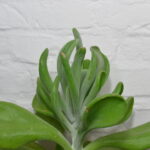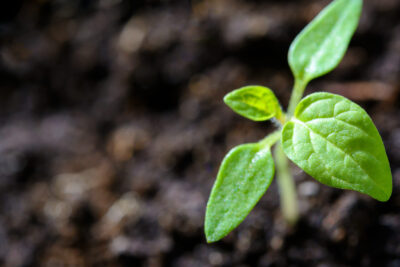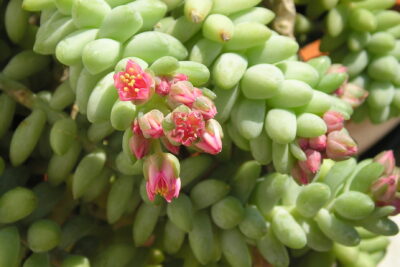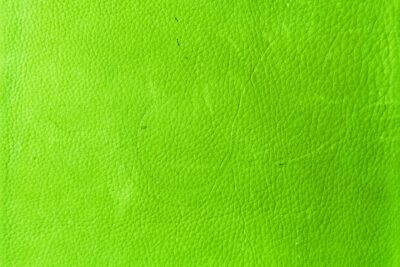
Popular Chalk Stick Succulents: Exploring Varieties and Names

Chalk stick succulents, also known as Senecio serpens, are a popular choice among succulent enthusiasts due to their unique appearance and low maintenance requirements. These plants are native to South Africa and are characterized by their thick, cylindrical leaves that resemble pieces of chalk. Chalk stick succulents are highly adaptable and can thrive in a variety of environments, making them a great choice for both indoor and outdoor gardens.
We will delve into the world of chalk stick succulents and explore the different varieties and names available. We will discuss the various colors and textures that these plants come in, ranging from the classic blue-gray to vibrant shades of purple and green. Additionally, we will provide tips on how to care for chalk stick succulents, including proper watering and sunlight requirements. Whether you are a seasoned succulent enthusiast or a beginner looking to add some unique plants to your collection, this article will provide you with all the information you need to know about chalk stick succulents.
- There are many popular varieties of chalk stick succulents to choose from
- Some popular chalk stick succulent varieties include Senecio serpens, Senecio mandraliscae, and Senecio talinoides
- These succulents are known for their chalky blue-green leaves and trailing growth habit
- Chalk stick succulents are easy to care for and are drought-tolerant
- They thrive in full sun to partial shade and well-draining soil
- Chalk stick succulents can be propagated through stem cuttings
- These succulents make great additions to rock gardens, containers, or hanging baskets
- Chalk stick succulents are low-maintenance plants that add a unique texture and color to your garden
- Frequently Asked Questions
There are many popular varieties of chalk stick succulents to choose from
Chalk stick succulents, also known as Senecio mandraliscae or Senecio serpens, are a popular choice for succulent enthusiasts due to their unique appearance and easy care requirements. These succulents feature long, slender, and cylindrical leaves that resemble sticks of chalk, hence their name. They are native to South Africa and thrive in dry, arid climates, making them a great addition to any succulent garden or indoor collection.
When it comes to chalk stick succulents, there is no shortage of variety. Here are some popular varieties and their unique characteristics:
1. Senecio mandraliscae
This variety is one of the most common and widely recognized chalk stick succulents. It has striking blue-green leaves that form a dense mat, creating a visually appealing groundcover. Senecio mandraliscae is known for its ability to tolerate full sun and drought conditions, making it ideal for xeriscaping or water-wise landscaping projects.
2. Senecio serpens
Also known as "Blue Chalksticks," Senecio serpens features powdery blue-gray leaves that have a slightly curved shape. This variety forms cascading or trailing clusters, making it a popular choice for hanging baskets and containers. Senecio serpens is a drought-tolerant succulent that can withstand intense heat, making it a great addition to sunny landscapes.
 Succulent Flowers: A Complete Guide to Blooming Beauty
Succulent Flowers: A Complete Guide to Blooming Beauty3. Senecio vitalis
Sometimes referred to as "Giant Chalksticks," Senecio vitalis is a larger variety of chalk stick succulent. It has thick, fleshy leaves that are bluish-gray in color. Senecio vitalis can grow up to 2 feet tall and 3 feet wide, making it a great focal point in succulent gardens or rockeries. This variety is also drought-tolerant and prefers full sun to partial shade.
These are just a few examples of the popular chalk stick succulents available to plant enthusiasts. Each variety has its own unique characteristics, but they all share a similar tolerance for dry conditions and a striking appearance that adds visual interest to any garden or indoor space.
Whether you're a beginner or an experienced succulent lover, chalk stick succulents are a versatile and visually appealing addition to any collection. Consider exploring the different varieties and names available to find the perfect chalk stick succulent to suit your personal style and growing conditions.
Some popular chalk stick succulent varieties include Senecio serpens, Senecio mandraliscae, and Senecio talinoides
Chalk stick succulents, also known as Senecio plants, are a group of drought-tolerant and visually striking succulents that are becoming increasingly popular among plant enthusiasts. These plants are characterized by their unique chalky appearance, which gives them their common name.
Among the various chalk stick succulent varieties, Senecio serpens, Senecio mandraliscae, and Senecio talinoides are particularly noteworthy for their beauty and resilience.
Senecio serpens
Senecio serpens, commonly known as blue chalk sticks, is a stunning succulent with elongated, finger-like leaves that resemble a cluster of blue-green sticks. This variety is native to South Africa and is highly valued for its ability to create a striking contrast in gardens and container arrangements. Senecio serpens is a low-growing plant that forms a dense mat, making it an excellent choice for ground cover or hanging baskets.
 The Rare Succulent: Uncovering Its Unique Qualities
The Rare Succulent: Uncovering Its Unique QualitiesSenecio mandraliscae
Senecio mandraliscae, also known as blue chalk fingers, is another captivating chalk stick succulent variety. It features slender, cylindrical leaves that have a vibrant blue-gray color and a waxy texture. This plant originates from Namibia and is particularly popular for its ability to thrive in hot and dry conditions. Senecio mandraliscae is often used in xeriscaping projects and rock gardens, as its unique color and shape add interest to any landscape.
Senecio talinoides
Senecio talinoides, commonly referred to as narrow-leaved chalk sticks, is a striking succulent with long, cylindrical leaves that resemble pencils or sticks of chalk. This variety is native to South Africa and adapts well to a variety of climates, making it a versatile choice for gardens and containers. Senecio talinoides is appreciated for its architectural form and is often used as a focal point in succulent arrangements or as a border plant.
When cultivating chalk stick succulents, it is important to provide them with well-draining soil and ample sunlight. These plants are drought-tolerant and prefer infrequent watering. They are also relatively low-maintenance, making them an ideal choice for both experienced gardeners and beginners.
Whether you choose Senecio serpens, Senecio mandraliscae, or Senecio talinoides, adding chalk stick succulents to your plant collection will undoubtedly bring a touch of unique beauty and resilience to your indoor or outdoor space.
These succulents are known for their chalky blue-green leaves and trailing growth habit
Succulents are a popular choice among plant lovers for their unique and eye-catching characteristics. One particular group of succulents that has gained significant popularity in recent years is the chalk stick succulents. These plants are known for their distinctive chalky blue-green leaves and trailing growth habit, making them an excellent choice for both indoor and outdoor gardens.
Varieties of Chalk Stick Succulents
There are several varieties of chalk stick succulents, each with its own unique charm and appeal. Here are some popular varieties:
- Senecio serpens: Also known as "Blue Chalksticks," this variety features slender, finger-like leaves that resemble pieces of chalk. It forms a dense mat and is perfect for ground cover or cascading out of containers.
- Senecio mandraliscae: Commonly known as "Blue Finger," this succulent has long, narrow, and cylindrical leaves that are a striking blue-green color. It creates a beautiful contrast when planted alongside other succulents or in rock gardens.
- Senecio vitalis: Known as "Narrow-leaf Chalksticks," this variety has long, thin leaves that are slightly curved. Its leaves turn a vibrant shade of purple when exposed to full sun, adding a dramatic touch to any garden.
- Senecio serpens 'Angel Wings': This cultivar features broader and rounder leaves compared to other chalk stick succulents. Its leaves have a powdery coating, giving them a soft and velvety texture, resembling angel wings.
Choosing the Right Chalk Stick Succulent
When selecting a chalk stick succulent for your garden or indoor collection, consider the following factors:
 Best Sun-loving Succulents for Tokyo: Top Choices & Tips
Best Sun-loving Succulents for Tokyo: Top Choices & Tips- Light Requirements: Most chalk stick succulents thrive in full sun or partial shade. Consider the lighting conditions in your space and choose a variety that matches those requirements.
- Watering Needs: Chalk stick succulents are drought-tolerant and prefer well-draining soil. They can withstand periods of dryness but may suffer from root rot if overwatered. Ensure you provide proper drainage for these plants.
- Growth Habit: Determine whether you want a trailing succulent for hanging baskets or a ground-covering variety. This will help you select the right type of chalk stick succulent for your desired aesthetic.
With their stunning blue-green leaves and trailing growth habit, chalk stick succulents are a fantastic addition to any plant collection. Whether you're a seasoned succulent enthusiast or a beginner gardener, these varieties are sure to captivate with their beauty and low-maintenance nature. Consider adding them to your garden or indoor space and enjoy the unique charm they bring.
Chalk stick succulents are easy to care for and are drought-tolerant
Chalk stick succulents, also known as Senecio mandraliscae, are a popular choice among succulent enthusiasts due to their striking blue-green color and their ability to thrive in dry conditions. These succulents are native to South Africa and belong to the Asteraceae family.
One of the main advantages of chalk stick succulents is their low maintenance requirements. They are incredibly drought-tolerant and can withstand long periods without water, making them perfect for those who tend to forget to water their plants regularly. In fact, overwatering can be detrimental to their health, so it is important to allow the soil to dry out between waterings.
Chalk stick succulents are also known for their ability to grow in a variety of conditions. They can tolerate both full sun and partial shade, making them versatile for different garden settings. However, they prefer well-draining soil to avoid root rot, so adding perlite or sand to the potting mix can help improve drainage.
Exploring the varieties of chalk stick succulents
Chalk stick succulents come in various varieties, each with its own unique characteristics. Here are a few popular ones:
- Senecio mandraliscae: This is the most common variety of chalk stick succulent. It features long, cylindrical leaves in a vibrant blue-green color. Its trailing habit makes it an excellent choice for hanging baskets or cascading over walls.
- Senecio serpens: Also known as "blue chalk sticks," this variety has shorter leaves compared to Senecio mandraliscae but exhibits a similar blue-green hue. It forms dense mats and is ideal as ground cover or for creating a textured look in succulent arrangements.
- Senecio vitalis: Commonly referred to as "narrow-leaf chalk sticks," this variety has narrower leaves and a slightly lighter shade of blue-green. It can grow up to 3 feet tall and is often used as a focal point in succulent gardens or as a border plant.
These are just a few examples of the chalk stick succulent varieties available. Each variety offers its own aesthetic appeal, allowing succulent enthusiasts to create diverse and visually captivating arrangements.
 Large and Lush: Discover the Succulents that Grow to Impressive Sizes
Large and Lush: Discover the Succulents that Grow to Impressive SizesWith their easy care requirements, vibrant colors, and versatility, it's no wonder chalk stick succulents have become a favorite among succulent lovers. Whether you're a seasoned gardener or a beginner, these succulents can add a touch of elegance and uniqueness to your indoor or outdoor space.
They thrive in full sun to partial shade and well-draining soil
When it comes to growing chalk stick succulents, providing the right conditions is crucial for their health and growth. These fascinating plants thrive in environments that offer full sun to partial shade and well-draining soil. This means that they can tolerate a wide range of sunlight exposure, making them versatile options for both indoor and outdoor gardens.
Chalk stick succulents, also known as Senecio mandraliscae or Senecio serpens, belong to the Asteraceae family. They are native to South Africa and are renowned for their unique chalky blue-green foliage, which adds a touch of elegance to any garden. Their leaves are cylindrical and grow in clusters, creating a stunning visual display.
Varieties of Chalk Stick Succulents
There are several varieties of chalk stick succulents to choose from, each with its distinct characteristics and growth habits. Here are some popular varieties you might consider:
- Senecio mandraliscae: This variety is known for its striking blue-gray leaves and can grow up to 1 foot tall. It forms a sprawling mat of foliage, making it an excellent ground cover option.
- Senecio serpens: Also known as "Blue Chalksticks," this variety features slender blue-green leaves that resemble fingers. It grows up to 6 inches tall and forms a clumping habit, creating a beautiful accent in rock gardens or containers.
- Senecio radicans: Commonly referred to as "String of Bananas," this variety has elongated leaves that resemble bananas, hence its name. It cascades beautifully from hanging baskets or containers, adding a unique touch to your garden.
These are just a few examples of the diverse chalk stick succulents available. Each variety brings its own charm and can enhance the aesthetic appeal of your garden in different ways.
Choosing the Right Chalk Stick Succulent for Your Garden
When selecting a chalk stick succulent for your garden, consider factors such as the available space, sunlight exposure, and the desired visual effect. If you have a large area to cover, Senecio mandraliscae could be an excellent choice, as its sprawling habit can quickly fill in empty spaces. On the other hand, if you prefer a more compact option for containers or small gardens, Senecio serpens or Senecio radicans might be more suitable.
 Explore Unique and Stunning Succulent Plants with Striking Names
Explore Unique and Stunning Succulent Plants with Striking NamesRemember to provide well-draining soil and avoid overwatering, as chalk stick succulents are adapted to drier conditions. With the right care and proper conditions, these succulents can thrive and become a stunning addition to your garden.
Explore the varieties and names of popular chalk stick succulents, and discover the beauty they can bring to your outdoor space. Whether you opt for the vibrant blue tones of Senecio mandraliscae or the cascading elegance of Senecio radicans, these succulents are sure to captivate your senses and add a touch of natural charm to your landscape.
Chalk stick succulents can be propagated through stem cuttings
Chalk stick succulents, also known as Senecio mandraliscae, are a popular choice for succulent enthusiasts. These unique plants are characterized by their thick, chalky blue-green leaves that resemble sticks of chalk. One of the reasons why they are so beloved by plant lovers is their ability to be easily propagated through stem cuttings.
To propagate chalk stick succulents, simply follow these steps:
- Choose a healthy parent plant: Look for a mature chalk stick succulent that is free from any signs of disease or damage. A healthy parent plant will ensure that your cuttings have the best chance of thriving.
- Select a stem for cutting: Find a stem that is at least 4-6 inches long and has a few sets of leaves. Using a clean, sharp pair of scissors or gardening shears, carefully cut the stem just above a leaf node. A leaf node is the point where a leaf is attached to the stem.
- Remove lower leaves: Strip off the lower sets of leaves from the stem, leaving only a few sets of leaves at the top. This will help redirect the plant's energy towards root development rather than leaf production.
- Allow the cutting to dry: Place the cutting in a warm, dry location out of direct sunlight. Allowing the cut end to callus over for a few days will help prevent rotting when it is planted.
- Prepare a well-draining potting mix: Chalk stick succulents prefer a well-draining soil mix. You can create your own by combining equal parts of cactus potting mix and perlite or pumice. Fill a small pot or container with this mixture.
- Plant the cutting: Once the cutting has calloused, gently insert the cut end into the potting mix, burying it about an inch deep. Press the soil around the cutting to ensure it remains upright.
- Provide appropriate care: Place the newly planted cutting in a bright location with indirect sunlight. Water sparingly, allowing the soil to dry out between waterings. Overwatering can lead to root rot, so it's important to exercise caution.
- Monitor growth: Over time, your cutting will develop roots and new growth. Be patient, as it may take a few weeks or even months for significant growth to occur. Once the cutting has established roots and is actively growing, you can treat it like a mature chalk stick succulent.
By following these steps, you can successfully propagate chalk stick succulents and expand your collection. Remember to exercise patience and provide proper care, and soon you'll be rewarded with a beautiful new plant to enjoy.
These succulents make great additions to rock gardens, containers, or hanging baskets
 Best Tall-Leafed Succulents for Indoor Thriving: A Guide
Best Tall-Leafed Succulents for Indoor Thriving: A GuideIf you're looking to add some unique and low-maintenance plants to your garden or indoor space, chalk stick succulents are an excellent choice. These hardy plants are known for their thick, fleshy leaves and ability to thrive in various conditions. With a wide range of varieties and names to choose from, you're sure to find one that catches your eye.
1. Senecio mandraliscae (Blue Chalksticks)
One of the most popular chalk stick succulents is Senecio mandraliscae, commonly known as Blue Chalksticks. This striking succulent features silvery-blue, finger-like leaves that grow in tight clusters. Blue Chalksticks is a perfect choice for rock gardens or as a groundcover, as it forms dense mats that spread quickly.
2. Senecio serpens (Blue Chalksticks 'Serbian')
Another variety of Blue Chalksticks is Senecio serpens, also known as Blue Chalksticks 'Serbian'. This succulent has similar characteristics to Senecio mandraliscae but with a more intense blue coloration. Its slender leaves create a cascading effect, making it an ideal choice for hanging baskets or tall containers.
3. Senecio vitalis (Narrow-leaf Chalksticks)
Sometimes referred to as Narrow-leaf Chalksticks, Senecio vitalis is a chalk stick succulent with long, thin leaves that are pale green in color. This variety forms upright clusters and can reach heights of up to 3 feet. Narrow-leaf Chalksticks is a great choice for adding vertical interest to your garden or as a centerpiece in a container.
- Key features of chalk stick succulents:
- Drought-tolerant
- Low water requirements
- Thrives in full sun
- Excellent groundcover options
- Attractive cascading or upright growth habits
Whether you're a beginner gardener or an experienced plant enthusiast, chalk stick succulents are a fantastic addition to any collection. Their unique textures, vibrant colors, and ability to withstand various conditions make them a popular choice for both indoor and outdoor spaces. Explore the different varieties and names available, and let these stunning succulents bring a touch of beauty to your garden.
Chalk stick succulents are low-maintenance plants that add a unique texture and color to your garden
If you're looking to add some interesting and eye-catching plants to your garden, chalk stick succulents are a great choice. These low-maintenance plants are known for their vibrant colors and unique texture, making them a popular choice among succulent enthusiasts.
 Discover the Must-Have Succulent Types for Your Collection
Discover the Must-Have Succulent Types for Your CollectionChalk stick succulents, also known as Senecio mandraliscae or blue chalk sticks, are native to South Africa. They are characterized by their long, slender, and chalky blue-green leaves that give them their name. These succulents can grow up to 2 feet tall and spread out, creating a beautiful ground cover or trailing effect when planted in containers or hanging baskets.
Popular varieties of chalk stick succulents
There are several varieties of chalk stick succulents that vary in color and leaf shape. Here are some popular ones:
- Senecio mandraliscae: This is the classic blue chalk stick succulent with its long, pencil-like leaves. It is a fast-growing variety and can tolerate full sun, making it a great addition to any sunny garden.
- Senecio serpens: Also known as blue chalk fingers, this variety has shorter, finger-like leaves that form dense mats. It is a more compact option and looks stunning when planted in rock gardens or used as a ground cover.
- Senecio vitalis: Commonly known as narrow-leaf chalk sticks, this variety has thinner leaves and a more upright growth habit. It is known for its stunning blue-green color and is a great choice for adding height to your succulent arrangements.
These are just a few examples of the wide range of chalk stick succulents available. Each variety brings its own unique beauty to your garden, making it a joy to explore and experiment with different combinations.
Choosing the right chalk stick succulent for your garden
When selecting a chalk stick succulent for your garden, consider the specific growing conditions in your area. While most varieties are drought-tolerant and prefer full sun, some may be more sensitive to frost or extreme heat. It's important to choose a variety that will thrive in your specific climate.
Additionally, consider the overall aesthetic you want to achieve in your garden. The different leaf shapes and colors of chalk stick succulents can create a variety of visual effects. Some varieties may be better suited for ground covers, while others may be perfect for adding height and texture to your arrangements.
With their unique texture, vibrant colors, and low-maintenance nature, chalk stick succulents are a fantastic addition to any garden. So, go ahead and explore the wonderful world of chalk stick succulents and bring a touch of elegance and beauty to your outdoor space.
Frequently Asked Questions
1. What are chalk stick succulents?
Chalk stick succulents are a type of plant that belong to the Senecio genus. They are known for their thick, cylindrical leaves that resemble sticks of chalk.
 Discover the Most Beautiful Succulents with White Flowers
Discover the Most Beautiful Succulents with White Flowers2. What are some popular varieties of chalk stick succulents?
Some popular varieties of chalk stick succulents include Senecio serpens (Blue Chalksticks), Senecio mandraliscae (Blue Finger), and Senecio radicans (String of Bananas).
3. How do you care for chalk stick succulents?
Chalk stick succulents prefer bright sunlight and well-draining soil. They are drought-tolerant and should be watered sparingly. It's important to avoid overwatering to prevent root rot.
4. Can chalk stick succulents be grown indoors?
Yes, chalk stick succulents can be grown indoors as long as they receive sufficient sunlight. Place them near a south-facing window or provide them with artificial grow lights.
If you want to read more articles similar to Popular Chalk Stick Succulents: Exploring Varieties and Names, you can visit the Varieties and Colors category.






You Must Read